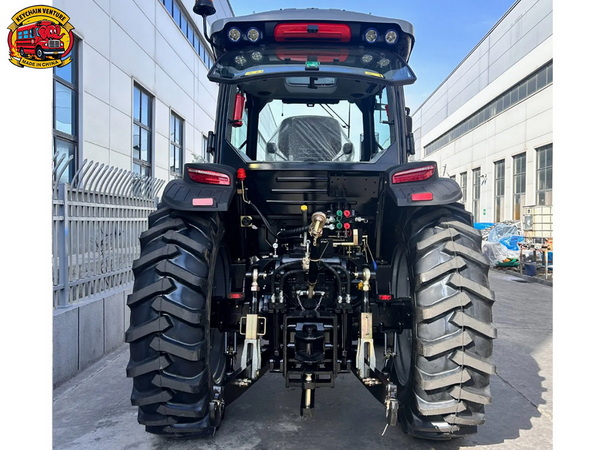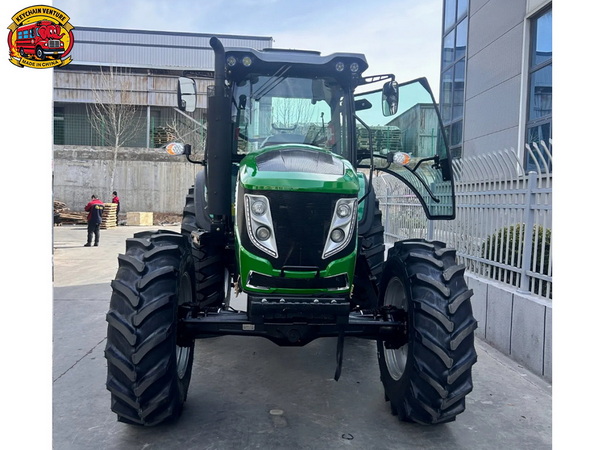Views: 222 Author: Amanda Publish Time: 2025-09-28 Origin: Site








Content Menu
● Can a Used Tractor Qualify for Section 179?
● Key Requirements for Section 179 Eligibility of Used Tractors
>> Timing and Placement in Service
● Financial Benefits of Using Section 179 for a Used Tractor
>> Immediate Expense Deduction
>> Eligibility for Bonus Depreciation
● Deduction Limits and Spending Caps (2025)
● How Heavy Vehicles and Tractors Are Treated
● Claiming Section 179 on a Used Tractor: Step-by-Step Guide
● Additional Considerations for Used Tractor Purchases
>> Equipment Condition and Documentation
>> Interaction with Other Tax Incentives
● FAQ
>> 1. Can my business claim Section 179 on any used tractor?
>> 2. What documentation is needed for Section 179 on a used tractor?
>> 3. Are there limits on how much I can deduct for a used tractor under Section 179?
>> 4. Does bonus depreciation apply to used tractors?
>> 5. Can I claim Section 179 if I lease a used tractor?
KeyChain Venture Co., Ltd., a leading commercial vehicle supplier in China serving customers domestically and internationally with high-performance buses and heavy trucks, presents a comprehensive guide on whether a used tractor qualifies for the IRS Section 179 tax deduction. This article explores the eligibility criteria, benefits, limits, and practical considerations of claiming Section 179 on a used tractor purchase, helping business owners make informed financial decisions.

Section 179 is a provision of the IRS tax code enabling businesses to immediately deduct the full purchase price of qualifying equipment from their taxable income in the year the equipment is placed into service. Instead of depreciating equipment over several years, businesses can write off 100% (up to a certain limit) of the cost in the first year, offering immediate tax relief and improved cash flow. This incentive encourages businesses to invest in necessary equipment to grow operations and remain competitive.[1][11]
A used tractor can qualify for the Section 179 deduction as long as it meets key IRS requirements. The equipment must be “new to the taxpayer,” which means the business claiming the deduction must be the first owner for tax purposes, though the tractor itself may be used or previously owned by someone else. Additionally, the tractor must be purchased and placed into service within the relevant tax year and used more than 50% of the time for business purposes.[5][11][12]
This means businesses can benefit from purchasing quality used tractors without losing out on valuable tax deductions, which is particularly important for smaller operations or those managing costs carefully.
To qualify for the deduction, the tractor must be used primarily for business—more than 50% of the time. If business use falls below this threshold, the deduction isn't eligible, or it must be prorated by the percentage of business use.[2][1]
The tractor must be purchased and placed into service within the tax year for which the deduction is claimed. “Placed into service” refers to the time when the equipment is ready and available for use in the business.[7][11]
The IRS requires that the equipment be tangible and depreciable property used in the active conduct of a trade or business. Tractors commonly used in agriculture, construction, and transport qualify as eligible equipment.[4][11]
Claiming Section 179 allows businesses to deduct the entire cost of a qualifying used tractor in the year it is put into service, rather than spreading out the expense over years through traditional depreciation. This direct expense deduction can significantly reduce taxable income and lower taxes owed for the year.[1][4]
The accelerated deduction improves cash flow by decreasing the initial tax burden, freeing up funds for other business investments such as maintenance, operational costs, or expansion.[11]
In addition to Section 179, businesses may claim bonus depreciation on qualifying property. For 2025, bonus depreciation allows for an additional 40% deduction on the remaining cost of the equipment after the Section 179 deduction is applied. This further accelerates tax savings and applies to both new and used qualified equipment.[3][1]

For the 2025 tax year, Section 179 allows a maximum deduction of $1,250,000 for qualifying equipment purchases, including tractors. This deduction limit starts to phase out when total equipment purchases exceed $3,130,000 and completely phases out at $4,380,000 in spending. Spending beyond these thresholds may still qualify for bonus depreciation.[7][1]
Tractors, typically classified as heavy vehicles with a gross vehicle weight rating (GVWR) over 14,000 pounds or specialized farm equipment, do not face the caps that apply to lighter passenger vehicles. Therefore, a used tractor generally qualifies for the full deduction up to the Section 179 limit without additional vehicle-specific restrictions.[2][5][1]
1. Purchase the Used Tractor: Acquire a tractor from a third party, ensuring it is new to your business.
2. Place the Tractor in Service: The tractor must be operational and ready for use in the tax year of purchase.
3. Determine Business Use: Confirm the tractor will be used more than 50% for business activities.
4. Calculate Deduction: Apply the Section 179 deduction up to the maximum allowed amount based on the purchase price and business use percentage.
5. File IRS Form 4562: Report the deduction on IRS Form 4562 when filing your tax return.
6. Consult a Tax Professional: Ensure proper filing and compliance with IRS rules for maximizing the deduction benefits.[9][13]
Keeping purchase documentation, receipts, and use logs is vital in case of an IRS audit. Businesses should maintain clear records to verify the purchase price, date, and percentage of business use.[14]
Tractors purchased on finance or lease agreements may still qualify for Section 179 deductions, though different rules apply. Lease agreements, for example, may not always permit immediate expensing under Section 179, so it's important to check eligibility based on the specific terms.[1]
Businesses should coordinate Section 179 deductions with other tax credits and incentive programs, such as state-level agricultural equipment credits or environmental grants if applicable, to maximize overall savings.[10]
Used tractors do indeed qualify for the IRS Section 179 deduction if they are new to the business, used primarily for business purposes, and placed in service within the tax year. This deduction allows companies to immediately expense the purchase price, improving cash flow and offering significant tax savings. With deduction limits of up to $1,250,000 and additional bonus depreciation options available in 2025, investing in used tractors is a strategic choice for businesses seeking cost efficiency. KeyChain Venture Co., Ltd. encourages consulting with tax professionals to ensure compliance and optimize deductions while continuing to supply high-performance commercial vehicles around the world.

Used tractors qualify as long as they are new to your business, used more than 50% for business, and placed into service in the tax year you claim the deduction.[11]
Maintain purchase receipts, proof of service date, and records of actual business use percentage to support your deduction claim.[14]
Yes, the maximum deduction for 2025 is $1,250,000, with spending phased out over $3,130,000 in total equipment purchases.[1]
Yes, after utilizing Section 179, businesses can claim 40% bonus depreciation on the remaining cost of the used tractor in 2025.[3]
Leases may have different rules; immediate Section 179 expensing might not be allowed. Consult a tax advisor to evaluate your specific lease agreement.[1]
[1](https://www.manhattanchrysler.com/section-179-tax-deductions.htm)
[2](https://www.rushtruckcenters.com/blog/2025/7/what-is-the-section-179-deduction)
[3](https://www.agdirect.com/resources/learning-center/section-179-update)
[4](https://www.nationwide.com/lc/resources/farm-and-agribusiness/articles/section-179-tax-deductions-for-farm-equipment-purchases)
[5](https://www.section179.org/section_179_deduction/)
[6](https://www.bobcat.com/na/en/buying-resources/loaders/section-179-deduction)
[7](https://www.irs.gov/publications/p946)
[8](https://www.vedderprice.com/100-bonus-depreciation-returns-what-obbba-means-for-aircraft-rail-and-heavy-equipment)
[9](https://thompsontractor.com/blog/used-equipment-taxes/)
[10](https://www.nationalfunding.com/blog/a-guide-to-the-section-179-deduction-and-its-changes/)
[11](https://www.arizonatractorsales.com/blog/understanding-irs-section-179-and-how-it-can-help-you-purchase-a-tractor--82763)
[12](https://www.newmantractor.com/news/section-179-used-new-heavy-equipment)
[13](https://www.ironcraftusa.com/news/section-179-tax-deduction-for-attachment-purchases/)
[14](https://colemantractor.com/specials/section-179)